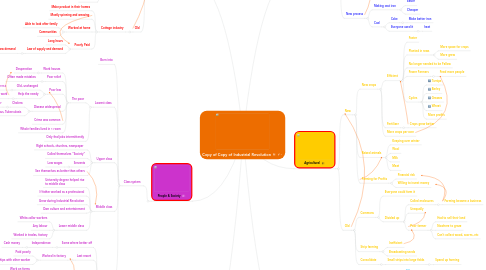
1. Factorization
1.1. New
1.1.1. Factory age
1.1.1.1. Factory Acts
1.1.1.1.1. Children
1.1.1.1.2. Laissez-faire
1.1.1.1.3. No inspectors to uphold the rules
1.1.1.1.4. Workers could not help themself
1.1.1.1.5. Improve the lives of working people
1.1.1.2. Dangerous evironmnets
1.1.1.2.1. Deafening nosie
1.1.1.2.2. Long overtime shifts
1.1.1.2.3. Air filled with microscopic fibres
1.1.1.2.4. Pollution
1.1.1.3. Large Factory build
1.1.1.3.1. Loud, dangerous, dirty
1.1.1.4. Child Labour
1.1.1.4.1. Useful because of small size
1.1.1.4.2. No other choice
1.1.1.4.3. Stunted growth, deformed bobies
1.1.1.5. Everything can be done in one place
1.1.1.6. Low wages
1.2. Old
1.2.1. Cottage industry
1.2.1.1. Make product in their homes
1.2.1.2. Mostly spinning and weaving
1.2.1.3. Worked at home
1.2.1.3.1. Able to look after family
1.2.1.3.2. Communities
1.2.1.4. Poorly Paid
1.2.1.4.1. Long hours
1.2.1.4.2. Law of supply and demand
2. People & Society
2.1. Class system
2.1.1. Born into
2.1.2. Lowest class
2.1.2.1. The poor
2.1.2.1.1. Work houses
2.1.2.1.2. Poor relief
2.1.2.1.3. Poor law
2.1.2.1.4. Disease widespread
2.1.2.1.5. Crime was common
2.1.2.1.6. Whole families lived in 1 room
2.1.2.2. Only find jobs intermittently
2.1.3. Upper class
2.1.3.1. Right schools, churches, newspaper
2.1.3.2. Called themselves "Society"
2.1.3.3. Servants
2.1.3.3.1. Low wages
2.1.3.4. See themselves as better than others
2.1.4. Middle class
2.1.4.1. University degree helped rise to middle class
2.1.4.2. If father worked as a professional
2.1.4.3. Grew during Industrial Revolution
2.1.4.4. Own culture and entertainment
2.1.4.5. Lower middle class
2.1.4.5.1. White-collar workers
2.1.4.5.2. Any labour
2.1.4.5.3. Worked in trades, factory
2.1.5. Women
2.1.5.1. Some where better off
2.1.5.1.1. Independence
2.1.5.2. Last resort
2.1.5.2.1. Worked in factory
2.1.5.3. Cottage system
2.1.5.3.1. Began to fade
2.1.5.3.2. Work cooperatively with husbands
2.1.5.3.3. worked as part of family
3. Transportation
3.1. Transport poeple
3.1.1. Stagecoach
3.2. Transport materials
3.2.1. Macadam roads
3.2.1.1. Large wagon can be used
3.2.1.2. Privately built
3.2.1.3. Tolls
3.2.2. Canals
3.2.2.1. Over 4000Km built
3.2.2.2. Reduce the shipping cost
3.2.2.3. Link rivers
3.2.3. Carry Raw Materials to factory
3.2.3.1. Cheaper and faster
3.2.3.1.1. Increased Profits
3.3. Railways
3.3.1. Most important transportation
3.3.1.1. Large Networks
3.3.1.1.1. All over Eurpoe
3.3.2. Unheard speed of 39kmph
3.3.3. Powered by steam engine
4. Inventions
4.1. Textiles
4.1.1. Faster weaving
4.1.1.1. Flying shuttle
4.1.1.1.1. Spring loaded
4.1.1.1.2. Large looms to opreate by 1 person
4.1.1.2. Larger looms
4.1.2. Faster spinning
4.1.2.1. Spinning Jenny
4.1.2.1.1. John Kay 1733
4.1.2.1.2. Spin multiple strands at the same time
4.1.2.2. Water frame
4.1.2.2.1. Improved strength of yarn
4.1.2.2.2. Faster than Jenny
4.1.3. Mule
4.1.3.1. Combined features of water frame and Jenny
4.2. New souce of power
4.2.1. Steam engine
4.2.1.1. Could be use in many different ways
4.2.1.1.1. Pump water
4.2.1.1.2. Power machines
4.2.1.1.3. Transportation
4.2.1.2. No need for water wheels
4.2.1.3. Practical
4.2.1.4. Efficient
4.3. New process
4.3.1. Making cast iron
4.3.1.1. Easier
4.3.1.2. Cheaper
4.3.2. Coal
4.3.2.1. Coke
4.3.2.1.1. Make better iron
4.3.2.2. Everyone used it
4.3.2.2.1. heat
5. Agricultural
5.1. New
5.1.1. New crops
5.1.1.1. Efficient
5.1.1.1.1. Faster
5.1.1.1.2. Planted in rows
5.1.1.1.3. No longer needed to be Fallow
5.1.1.1.4. Fewer Farmers
5.1.1.1.5. Cycles
5.1.1.2. Fertilizer
5.1.1.2.1. Crops grew better
5.1.1.3. More crops per acre
5.1.2. Raised animals
5.1.2.1. Keeping over winter
5.1.2.2. Wool
5.1.2.3. Milk
5.1.2.4. Meat
5.1.3. Farming for Profits
5.1.3.1. Financial risk
5.1.3.2. Willing to invest money
5.2. Old
5.2.1. Commons
5.2.1.1. Everyone could farm it
5.2.1.2. Divided up
5.2.1.2.1. Called enclosures
5.2.1.2.2. Unequally
5.2.1.2.3. Poor farmer
5.2.2. Strip farming
5.2.2.1. Inefficient
5.2.2.2. Broadcasting seeds
5.2.3. Consolidate
5.2.3.1. Small strips into large fields
5.2.3.1.1. Speed up farming
6. Textiles
6.1. Colonies
6.1.1. Supplement supplies
6.1.1.1. Silk
6.1.1.2. Wool
6.1.1.3. Cotton
6.2. High demand
6.2.1. Very profitable
6.2.2. Cloth made cheaply and fast
6.2.3. Large spinning/weaving factory
6.3. Enormous looms
6.3.1. Power by steam
6.3.2. Too big for human power
6.4. Making cloth
6.4.1. Cleaned
6.4.2. Spun into thread
6.4.3. Weaved into new cloth
6.5. Inventions
6.5.1. Speed up production
6.5.2. Spinning
6.5.2.1. Spinning jenny
6.5.2.1.1. Spun thread too fast
6.5.3. Weaving
6.5.3.1. Flying shuttle
6.5.3.1.1. Large looms operated by one person
6.5.3.1.2. Spring loaded
